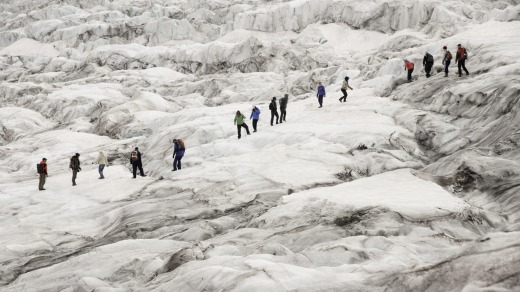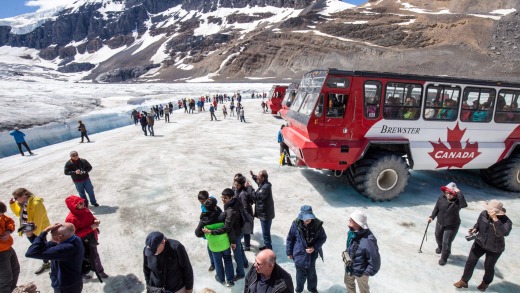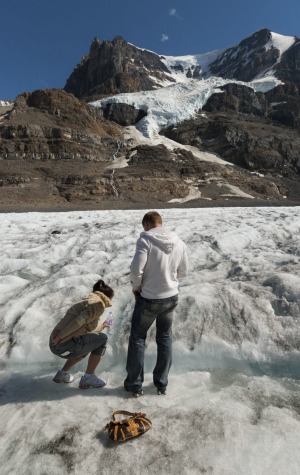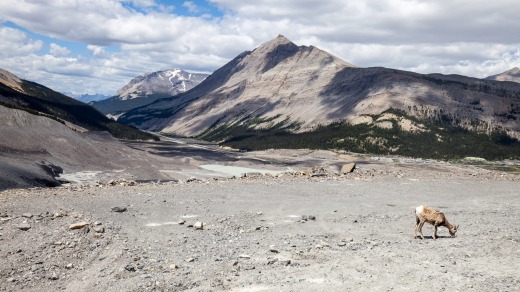At 2200 metres above sea level, and spanning roughly six kilometres wide by a kilometre long, the Athabasca Glacier is the second largest to flow off the Columbia Icefield. The Icefield Explorer takes you on to it. Video: Brewster Travel.
Michael Rex is about to guide his 4325th excursion on the glacier. He claims to keep count. Then again, almost everything that comes out of Rex's mouth is a wisecrack so it's tricky to know whether to take him seriously.
Head to toe in black thermal gear, with blue polarised sunglasses and a russet beard, Rex is ushering us on board his Ice Explorer, a behemoth of a vehicle that would make your average monster truck look like a toy.
We are on the outer perimeter of the Athabasca Glacier, one of six main toes in the Columbia Icefield in the Canadian Rocky Mountains. Close to the Icefields Parkway – among the most scenic highways in Canada – it's also midway between the towns of Jasper, Banff and Alberta.

On the mic, Rex begins peppering us with his machinegun-fire spiels and rapier wit.
"Whoops, better not run over the mechanic, might need him to fix things later," he says pulling out of the parking area.
From our raised vantage point, (the truck's tyres are the size of small buildings) the landscape is a kind of lunar grey, piles of gravel and glacial debris known as terminal and lateral moraines adding to the whole science-fiction feeling of the outing.

At the base of the glacier, beyond a smattering of raggedy bighorn sheep, lies a lake – its surface battleship grey from glacial minerals. With a crisp blue sky, visibility is almost perfect; the plunging faces of the Rockies starkly juxtaposed by sparkling snow, patches of pine trees covering periodic lower sections.
As we near the glacier, we approach one of the steepest, drivable hills in North America. Cranking it into first gear, Rex edges the truck – all 25 tonnes of it – down a 32 per cent gradient. Locking the engine and transmission into the same speed, we're soon nosediving at such an angle there is only the view of gravel road through the expansive front windscreen.
Once on the glacier we're allowed off the Explorer to wander the ice.

At 2200 metres above sea level, and spanning roughly six kilometres wide by a kilometre long, the Athabasca Glacier is the second largest to flow off the Columbia Icefield.
As with many glaciers, it's receding at an alarming rate, an average of 10 metres, Rex says, although last season it was double that. Most scientists estimate that in 50 to 60 years, Athabasca will have vanished.
Walking on its surface is a peculiar sensation, hundreds of people meandering its brilliant white surface, reminiscent of a winter scene by British painter, L. S. Lowry. Beside them, a fleet of Ice Explorers stand parked in a parallel line and I have to remind myself the ice is 250 metres thick.

It's all a far cry from the days of early explorers Norman Collie, Herman Wooley and Hugh Stutfield who had the first documented experience of seeing the ice field after summiting Mount Athabasca in 1898.
Collie famously remarked: "The view that lay before us in the evening light was one that does not often fall to the lot of modern mountaineers.
"A new world was spread at our feet: to the westward stretched a vast ice field probably never before seen by the human eye, and surrounded by entirely unknown, unnamed and unclimbed peaks."

How times have changed.
canada.Travel
Qantas is offering three weekly direct flights between Sydney and Vancouver during the US summer and winter periods in 2016. See qantas.com
Brewster Travel offers glacier tours every 15-30 minutes departing from the Columbia Glacier Icefield Discovery Centre. An 80 minute tour starts at $55. See brewster.ca